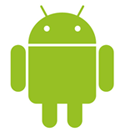Android: Now beaming I/O videos and presentations to the world

Google I/O was one
of Android's biggest events of the year, with a Mobile track that focused primarily on all
things Android, and 22 developers showcasing some of their great Android applications at the
Google I/O developer sandbox.
For those
of you who missed I/O or could not make all the Android sessions, we're excited to release
session videos and presentations from the Mobile track
online and free to developers worldwide.
At this year's I/O, we wanted
to help developers further optimize their applications for the Android platform by creating
better user experiences. Romain Guy explored techniques for
making Android apps faster and more
responsive using the UI toolkit. Chris Nesladek discussed the
use of interaction design
patterns in the Android system framework to create an optimal user experience. Since
mobile application development is inextricably tied to
battery performance, Jeff Sharkey provided an
insightful look at the impact of different application features and functionalities on battery
life. Taking the mobile experience further, T.V. Raman and Charles Chen
discussed building applications
that are optimized for eyes-busy environments, taking advantage of the Text-to-Speech library,
as well as new UI innovations that allow a user to interface with the device without needing
to actually look at the screen.
We also offered a few sessions on
building compelling and fun apps that take advantage of the Android media framework and 2D and
3D graphic libraries. Chris Pruett
discussed the gaming engine that he built and
used as a case study to explain best practices and common pitfalls in building
graphics-intensive applications. David Sparks
lifted the hood on the
infrastructure by diving into Android's multimedia capabilities and expanding on how
to use them to write secure and battery-efficient media code.
We also
had several sessions that meditate on challenges, best practices, and philosophies for writing
apps for Android. Dan Morrill
demonstrated multiple
techniques for developing apps for Android in different scenarios, to help
developers make the right decisions on the right techniques for writing their apps. Joe
Onorato talked to developers about leveraging Android's ability to support multiple hardware
configurations to
make their
applications run on a wide variety of devices without the overhead of building a
custom version for each. Justin Mattson talked about
advanced usage of Android debugging
tools in his session and presented real-world examples in which these tools were
used at Google.
Lastly, Robert Kroeger returns from the frontlines of
launching Gmail Mobile Web for iPhone and Android's offline capabilities and shares the team's
experiences in using a portable write-through caching layer running on either HTML 5 or Gears
databases to
build offline-capable web
applications.
We hope these session videos and presentations
are helpful to all Android developers out there. Don't forget to check out our newly announced
Android Developer Challenge 2 - we look forward to seeing your passion,
creativity, and coding prowess come together in the great apps you submit in this next
challenge!
By Azhar Hashem, Google Developer Products